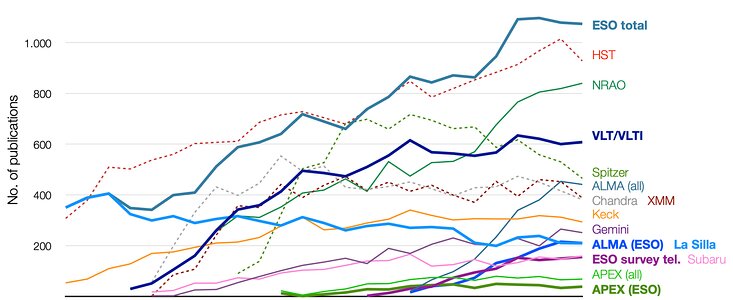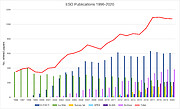Tiedote
Yli 1000 julkaistua tutkimusta ESO:n dataan perustuen: Katsaus ESO:n tieteellisiin tuloksiin vuodelta 2020
20. toukokuuta 2021
ESO:n observatoriot toimivat vuonna 2020 haastavissa olosuhteissa yllättävän COVID-19-pandemian vuoksi, ja sen seurauksena observatorioissa tehtäviä tieteellisiä havaintoja oli vähennettävä, ja jopa keskeytettävä muutamaksi kuukaudeksi. Vuosi 2020 oli kuitenkin edelleen erittäin tuottelias niiden tutkimusartikkelien lukumäärän osalta, jotka julkaistiin ESO-teleskooppeilla kerättyyn dataan perustuen. Tästä datasta suuri osa oli aikaisempina vuosina kerättyä. ESO-kirjaston äskettäin julkaistusta raportista käy ilmi, että 2020 on neljäs peräkkäinen vuosi, jolloin julkaistiin yli 1000 ESO-dataa hyödyntävää tieteellistä tutkimusta.
Suurin osa näistä julkaisuista (yli 600) hyödynsi ESO:n huipputeleskoopin eli Very Large Telescope (VLT) kaukoputken ja VLT-interferometrin (VLTI) dataa. Huippulöytöjä olivat esimerkiksi ensimmäinen kuva usean planeetan järjestelmästä Auringon kaltaisen tähden ympärillä ja tähden ”tanssin” havainnot supermassiivisen mustan aukon ympärillä.
Tutkimuksista 608 käytti VLT ja VLTI havaintoja, ja 336 (55%) käytti Multi Unit Spectroscopic Explorer (MUSE), Ultraviolet-Visual Echelle Spectrograph (UVES) tai X-shooter spektrografin dataa. Nämä olivat kolme tuotteliainta VLT-instrumenttia vuonna 2020, kuten oli myös vuonna 2019.
ESO:n Paranal Observatoriossa Pohjois-Chilessä sijaitsevien taivaan kartoitusteleskooppien Visible and Infrapuna Survey Telescope for Astronomy (VISTA) ja VLT Survey Telescope (VST) tuottama data johti yli 150 julkaistuun artikkeliin vuonna 2020, aivan aiempien vuosien mukaisesti. Yksi merkittävä tutkimustulos, jossa käytettiin VST:n tietoja yhdistettynä ESO:n VLT:n ja New Technology teleskoopin tietoihin, osoitti, kuinka kuumissa tähdissä on jättimäisiä magneettisia pilkkuja.
ESO:n vanhimmasta observatoriosta La Sillasta kerättyjen tietojen avulla julkaistiin noin 200 artikkelia. Näistä merkittävä osa (122) tuli High Accuracy Radial velocity Planet Searcher (HARPS) instrumentista. Tämä on asennettu ESO:n 3,6-metriseen teleskooppiin, joka on valjastettu eksoplaneettojen etsimiseen ja tutkimiseen.
Atacama Large Millimetri/Submillimeter Array (ALMA), jossa ESO on mukana yhteistyökumppanina, toimitti dataa yli 440:n artikkelin tarpeisiin. Lähes puolet (48%) näistä hyödynsi Euroopalle varattua ALMA-aikaa. Yksi tutkimustuloksista on tammikuussa 2020 julkaistu tutkimus yhden elämän rakennuspalikan tähtienvälisestä yhteydestä.
ESO on yhteistyökumppani myös Atacama Pathfinder Experiment (APEX) havaintolaitteessa, joka sijaitsee ALMA:n lähellä Chajnantorin tasangolla Chilen Atacaman alueella. Vuonna 2020 ESO:n APEXin havaintoaikana saadut havainnot olivat mukana yli puolessa (56%) kaikista APEX-havainnoista tehdyissä tutkimuksissa.
Jo toisena vuotena peräkkäin yli kolmannes (36%) kaikista vuonna 2020 julkaistuista ESO artikkeleista käytti havaintoja, jotka perustuivat osittain tai yksinomaan ESO:n arkistodataan. Tämä korostaa sitä, että jo tehdyt havainnot ovat edelleen tähtitieteilijöiden käytössä ja johtavat uusiin tieteellisiin läpimurtoihin. Tämä tapahtuu joskus vuosia sen jälkeen, kun ne on alun perin tehty. Vaikka tänä vuonna saatu data jääkin vähäisemmiksi observatorioiden sulkuaikojen vuoksi, niin vanhempaa ESO-dataa käytetään edelleen tähtitieteen tutkimuksen edistämiseksi.
Nämä vaikuttavat julkaisutilastot korostavat ESO:n merkittävää roolia tähtitieteen tutkimuksessa. ESO:n ja muiden observatorioiden julkaisutilastojen välistä vertailua vaikeuttaa se, että eri instituutiot käyttävät erilaisia menetelmiä tieteellisten tutkimusten laskemiseksi. Tästä huolimatta ESO on pysynyt maailman tuottavimpana maaanpäälisenä observatoriona myös vuonna 2020 ja ESO:n datan avulla on julkaistu yli 1000 tutkimusartikkelia.
Lisätietoja
Luvut on julkaistu vuotuisessa "Basic ESO Publication Statistics"-tilastossa, jota ESO:n kirjasto ja informaatiokeskus (ESO’s Library and Information Centre) julkaisee, ja ne on laskettu käyttäen ESO Telescope Bibliography (telbib) -tietokantaa, joka käsittää ESO:n havaintoaineistoa käyttäen tuotetut referoidut tutkimusjulkaisut. ESO tekee merkittäviä ponnistuksia tunnistaakseen kaikki ESO:n havaintoaineistoa käyttäneet referoidut julkaisut ja pitää telbib-tietokantaa käytännössä täydellisenä.
Valikoitujen tilastojen interaktiiviset kuvaajat ovat myös esillä verkossa. Nämä kuvaajat kayttävät telbib-tietokannan koko aineistoa, joka sisältää tiedot julkaisuista vuodesta 1996 tähän päivään. Niitä voi käyttää julkaisuhistorian monien eri tekijöiden tutkimiseen, mukaanlukien ESO:n eri instrumenteista peräisin olevien tieteellisten julkaisujen kehittymisen ja arkistoaineiston tutkimuskäytön.
ALMA on kansainvälinen tähtitieteen tutkimusyksikkö. Se on ESO:n, U.S. National Science Foundation of Japan:in eli NSF:n kumppanuushanke yhteistyössä Chilen tasavallan kanssa.
Linkit
Yhteystiedot
Uta Grothkopf
ESO Librarian
Garching bei München, Saksa
S-posti: uta.grothkopf@eso.org
Bárbara Ferreira
ESO Media Manager
Garching bei München, Saksa
Puh.: +49 89 3200 6670
S-posti: press@eso.org
Tiedotteesta
| Tunnistus: | ann21006 |
Our use of Cookies
We use cookies that are essential for accessing our websites and using our services. We also use cookies to analyse, measure and improve our websites’ performance, to enable content sharing via social media and to display media content hosted on third-party platforms.
ESO Cookies Policy
The European Organisation for Astronomical Research in the Southern Hemisphere (ESO) is the pre-eminent intergovernmental science and technology organisation in astronomy. It carries out an ambitious programme focused on the design, construction and operation of powerful ground-based observing facilities for astronomy.
This Cookies Policy is intended to provide clarity by outlining the cookies used on the ESO public websites, their functions, the options you have for controlling them, and the ways you can contact us for additional details.
What are cookies?
Cookies are small pieces of data stored on your device by websites you visit. They serve various purposes, such as remembering login credentials and preferences and enhance your browsing experience.
Categories of cookies we use
Essential cookies (always active): These cookies are strictly necessary for the proper functioning of our website. Without these cookies, the website cannot operate correctly, and certain services, such as logging in or accessing secure areas, may not be available; because they are essential for the website’s operation, they cannot be disabled.
Functional Cookies: These cookies enhance your browsing experience by enabling additional features and personalization, such as remembering your preferences and settings. While not strictly necessary for the website to function, they improve usability and convenience; these cookies are only placed if you provide your consent.
Analytics cookies: These cookies collect information about how visitors interact with our website, such as which pages are visited most often and how users navigate the site. This data helps us improve website performance, optimize content, and enhance the user experience; these cookies are only placed if you provide your consent. We use the following analytics cookies.
Matomo Cookies:
This website uses Matomo (formerly Piwik), an open source software which enables the statistical analysis of website visits. Matomo uses cookies (text files) which are saved on your computer and which allow us to analyze how you use our website. The website user information generated by the cookies will only be saved on the servers of our IT Department. We use this information to analyze www.eso.org visits and to prepare reports on website activities. These data will not be disclosed to third parties.
On behalf of ESO, Matomo will use this information for the purpose of evaluating your use of the website, compiling reports on website activity and providing other services relating to website activity and internet usage.
Matomo cookies settings:
Additional Third-party cookies on ESO websites: some of our pages display content from external providers, e.g. YouTube.
Such third-party services are outside of ESO control and may, at any time, change their terms of service, use of cookies, etc.
YouTube: Some videos on the ESO website are embedded from ESO’s official YouTube channel. We have enabled YouTube’s privacy-enhanced mode, meaning that no cookies are set unless the user actively clicks on the video to play it. Additionally, in this mode, YouTube does not store any personally identifiable cookie data for embedded video playbacks. For more details, please refer to YouTube’s embedding videos information page.
Cookies can also be classified based on the following elements.
Regarding the domain, there are:
- First-party cookies, set by the website you are currently visiting. They are stored by the same domain that you are browsing and are used to enhance your experience on that site;
- Third-party cookies, set by a domain other than the one you are currently visiting.
As for their duration, cookies can be:
- Browser-session cookies, which are deleted when the user closes the browser;
- Stored cookies, which stay on the user's device for a predetermined period of time.
How to manage cookies
Cookie settings: You can modify your cookie choices for the ESO webpages at any time by clicking on the link Cookie settings at the bottom of any page.
In your browser: If you wish to delete cookies or instruct your browser to delete or block cookies by default, please visit the help pages of your browser:
Please be aware that if you delete or decline cookies, certain functionalities of our website may be not be available and your browsing experience may be affected.
You can set most browsers to prevent any cookies being placed on your device, but you may then have to manually adjust some preferences every time you visit a site/page. And some services and functionalities may not work properly at all (e.g. profile logging-in, shop check out).
Updates to the ESO Cookies Policy
The ESO Cookies Policy may be subject to future updates, which will be made available on this page.
Additional information
For any queries related to cookies, please contact: pdprATesoDOTorg.
As ESO public webpages are managed by our Department of Communication, your questions will be dealt with the support of the said Department.


